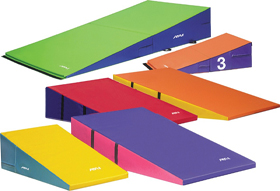
Foam for Gymnastics

Gymnastics, tumbling and cheerleading incorporate many advanced skills – a number of which take years to master and practice. Most athletes are guided by a qualified coach alone, however, there are an increasing number now also incorporating training aids into their learning.
These training aids vary depending on the intended skill to be developed and come in a huge range of shapes and sizes. Similar to crash mats and gym pits made from foam cubes, these training aids are made of a severe-high to high-density polyurethane foam – a density that is needed in order to support an athlete’s full body weight if required. These supports are conventionally used when developing a range of advanced skills, yet they can also be used for learning and refining the basics.
The most popular type of training aid is the incline block, often found in a range of sizes although most commonly between 1.5m and 2m in length. Created in a range of inclines depending on needs, these mats support athletes with the development of rolling skills, bridges, and for training and conditioning activities. Suitable for all ages and sizes, incline supports are popular for training the fundamental skills in gymnastics and cheerleading, including the cartwheel and handstand to forward roll.
For additional basic skills, single foam blocks measuring approximately 1m x 0.75m and 15cm in depth are used. Commonly known as ‘homework’ blocks, these rectangular blocks are often coated with a PVC fabric cover and marked with two small circles or template handprints. These aids are popular for gymnasts and cheerleaders who are learning the correct training for handstands and cartwheels, with the hand marks often useful as an introduction to learning round offs. The ‘homework’ name stems from their popularity with young athletes who use them to continue their basic training at home.

For techniques like front and back handsprings, octagonal tumbler foam blocks aid both the movement and support of an athlete. Unlike a smooth cylinder shape that may cause an athlete to move too fast and risk potential injury in the case of wrong technique, an octagonal shape encourages movement of both the athlete and block aid at a safe pace. The octagonal tumbler is seen as the most universal of training aids, helping to teach leaps, over slips, backwards and forwards skills (including flips and handsprings) and walkovers.
All training aids are frequently made from very high-density polyurethane foams and rigid closed cell polyethene foams. EVA foam is another popular choice due to its durability and resistance to indentation on impact. As training aids often come in a range of shapes and sizes, many may decide to fully personalise their aid by creating their own using eFoam’s cut to size capabilities.
If you’re requiring a preferred inner foam material or a specific set of measurements, contact one of our friendly advisors today for tailored advice on foam choice and other requirements.

